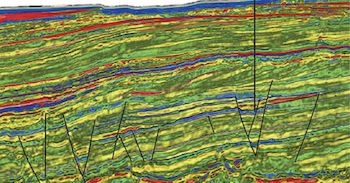Seismic Inversion
Our seismic inversion workflow is capable of handling 2D or 3D input data independently or in combination. For example, wells on matched 2D lines are tied to a 3D survey for both inversion calibration and model-building constraints. In the absence of well data within a survey (or tie-lines), wavelets can be derived statistically and models can be built entirely using regional rock physics trend information.
The seismic inversion engine is used to simultaneously invert for P and S impedance and density (depending on the data quality), at every trace location. This quantifies the elastic properties from the AVO/AVA effect present in the seismic data. The inversion can be performed using both band-limited (or relative) and absolute elastic impedance. Laterally- and time-varying wavelets are also supported (independently if required) for each angle stack while additional rock property derivatives can be calculated, including Vp/Vs, Poisson's ratio, Lambda-Rho and Mu-Rho.
The simultaneous inversion process (relative and absolute) is conducted in conjunction with a depth dependent rock physics model and involves the following steps:
- Statistical or Bayesian wavelet extraction
- Low frequency model building
- Geostatistical depth conversion
- Seismic inversion QC and production
- Bayesian lithology/fluid prediction
The results of the simultaneous inversion can be quantitatively integrated with the expected results from the statistical rock physics and stochastic modeling workflow, for the purpose of lithology and fluid prediction and uncertainty assessment.














